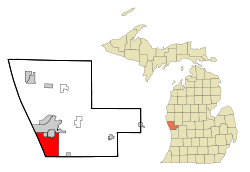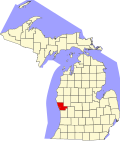2010 census
As of the census [8] of 2010, there were 23,994 people, 9,977 households, and 6,667 families residing in the city. The population density was 1,032.4 inhabitants per square mile (398.6/km2). There were 10,939 housing units at an average density of 470.7 per square mile (181.7/km2). The racial makeup of the city was 91.8% White, 3.2% African American, 0.8% Native American, 1.2% Asian, 1.0% from other races, and 2.0% from two or more races. Hispanic or Latino residents of any race were 3.8% of the population.
There were 9,977 households, of which 28.5% had children under the age of 18 living with them, 52.8% were married couples living together, 10.1% had a female householder with no husband present, 3.9% had a male householder with no wife present, and 33.2% were non-families. 27.6% of all households were made up of individuals, and 12.4% had someone living alone who was 65 years of age or older. The average household size was 2.39 and the average family size was 2.90.
The median age in the city was 43.3 years. 22% of residents were under the age of 18; 8.1% were between the ages of 18 and 24; 22.3% were from 25 to 44; 29.9% were from 45 to 64; and 17.8% were 65 years of age or older. The gender makeup of the city was 48.6% male and 51.4% female.
2000 census
As of the census [3] of 2000, there were 22,527 people, 8,996 households, and 6,396 families residing in the city. The population density was 969.2 inhabitants per square mile (374.2/km2). There were 9,679 housing units at an average density of 416.4 per square mile (160.8/km2). The racial makeup of the city was 94.63% White, 1.63% African American, 0.73% Native American, 0.84% Asian, 0.01% Pacific Islander, 0.63% from other races, and 1.53% from two or more races. Hispanic or Latino of any race were 2.69% of the population.
There were 8,996 households, out of which 30.7% had children under the age of 18 living with them, 60.0% were married couples living together, 8.1% had a female householder with no husband present, and 28.9% were non-families. 24.9% of all households were made up of individuals, and 11.7% had someone living alone who was 65 years of age or older. The average household size was 2.48 and the average family size was 2.97.
In the city, 24.8% of the population was under the age of 18, 6.6% was from 18 to 24, 25.8% from 25 to 44, 25.5% from 45 to 64, and 17.3% was 65 years of age or older. The median age was 41 years. For every 100 females, there were 94.3 males. For every 100 females age 18 and over, there were 91.2 males.
The median income for a household in the city was $45,457, and the median income for a family was $53,447. Males had a median income of $38,115 versus $26,728 for females. The per capita income for the city was $22,713. About 3.7% of families and 5.3% of the population were below the poverty line, including 6.3% of those under age 18 and 3.0% of those age 65 or over.

